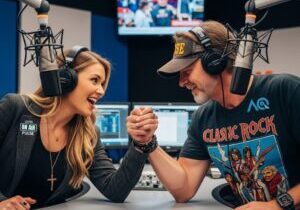
Sometimes I have a tendency to get a bit carried away with convenient sports analogies. And why not? Most of us have a favorite sport(s) we follow or tune into when our team or favorite player gets hot.
And sports franchises are popular because our workplaces are now made up of “teams.” I hear the jargon when dealing with a wide array of clients. While your station or organization may not have a sweaty locker room (at least I hope not), many of the other trappings from competitive gameplay are very much in place – at events, in the conference room mapping out a strategy, or in the studio where much of the live action takes place.
Our brands and how we deploy them are layered in “sports talk,” whether we’re launching a new product and “it’s the top of the first inning,” or we’re trying to salvage a downtrodden brand by “throwing a Hail Mary.” Our morning host may be known as the “quarterback” while the best in the business are now considered “GOATS.” And while the goal is to win both in audience and in revenue, our brands interact in their communities in virtually the same way a hometown sports franchise interacts with its local community – from charity work to engagement to visibility.
And so ESPN’s current path has caught my attention and its worthy of yours as well. While they have the tradition of being first-in and they are often considered synonymous with sports journalism, entertainment, and coverage, their road in the media morass is probably similar to what many stations and broadcast companies have weathered the past several years.
A recent edition of Axios broke down ESPN’s sojourn, and frankly, the analogies are so rich and relevant, I wanted to share the highlights with you – yes, my version of SportsCenter.
Here is a list of ESPN moves, assumptions, and experiments that represent the brand in transition. You can decide which, if any, might be applicable to your personal, professional, or company brand and persona.
And realize that historically, ESPN has spiraled into a massive sports network on cable TV, in much the same way radio stations are tethered to transmitters and towers. As we know so well, “cord cutters” are making life precarious for cable networks of all sizes.
Both ESPN and your radio station or company have made serious investments over the last many years, branching out into streaming, mobile, social, and the other tech tributaries. But at the end of the day, ESPN is a group of cable TV channels and radio stations are AM and FM first.
1. Read the demographic writing on the wall – ESPN is finally biting that bullet, while broadcast radio refuses to or is unable to face its aging visage – at its own peril. Take it from ESPN’s content president Burke Magnus, “We need to set up this company to be relevant for the next generation of sports fans.” There – he said it. And that sends a powerful message to the thousands of its employees that new tablets have come down from Mt. Bristol. Referring to it as “life after cable,” it’s a new day at ESPN.
2. A new emphasis on lifestyle – ESPN is acknowledging that the center of their universe is not a group of leagues and teams. They are embracing the reality that sports is a lifestyle – and that means an all-new emphasis on “sports betting, streaming, and its social media presence.” In essence, ESPN has had to re-establish what it stands for in 2024 – and beyond. It is no longer just scores and highlights, but fan engagement that reflects how sports has become life for millions of consumers.
It’s similar for radio. People are not solely defined by their taste in music – Country, Classic Rock, Hip-Hop, Pop. Instead, they’re into music, but their lives are defined by other things – family, hobbies, work – you name it. Understanding the lifestyles of your audience and the communities they make part of their lives is very much like the process ESPN is enduring.
3. A new emphasis on diverse content and variety – As we know in radio, the hits are the hits. But the world of streaming provides much-needed variety and depth. Axios explains how a new streaming platform will combine all the various networks, including what is being referred to as “smaller sports.” Plus, “ESPN Fantasy” – another lifestyle feature – and sports betting will be folded into the service, now called “Flagship.”
How can radio expand its programming and lifestyle horizons? How can brands leverage other content portals to provide more than simply banging the same 250 songs?
4. Personalization is part of the package – Hello, AI. Earlier this summer, I blogged about NBC’s use of the technology to create personalized Olympics wrap-ups using the voice of Al (“AI”) Michaels (below) We tested the concept in our new research study of air talent, AQ6. (The results will be presented in today’s webinar which you can still register for here.)
Is there a personality play for radio, where AI could be used so the big station personality could be used in a birthday video that is customized to a listener and what happened on that date?
5. ESPN is taking risks – Note that the network didn’t have a history for rolling the dice now and then. But ESPN’s new transformation package is loaded with new features that may have been considered “too radical” by past execs or ESPN’s Disney parents.
Aside from the new emphasis on sports betting, part of a $2 billion collaboration with Penn Gaming, ESPN is also set to open retail sportsbooks, an indication that boots on the ground is a necessity in the new plan.
billion collaboration with Penn Gaming, ESPN is also set to open retail sportsbooks, an indication that boots on the ground is a necessity in the new plan.
In radio, we see an increased emphasis on “eye contact’ with listeners, especially in our public radio surveys, including the coming-soon PRTS 2024.
And check this out: a new “where to watch” feature on ESPN’s app won’t just direct users to the games carried on its own networks. Instead, it will show fans how to watch games, whether ESPN holds the rights to them – or not. The network would have never done this in the past, but it’s a different day with a new audience.
6. ESPN’s new embrace of social – Of course, the networks and its personalities have had strong presence on every major social brand from the jump. But as part of its new transformation, ESPN is doubling down on platforms like TikTok where it boasts 47 million followers.
Axios says ESPN influencers will now be given “unprecedented access” to its events and gatherings in order to facilitate its creator network. This new reliance on CGM – consumer generated media – represents another sign ESPN is looking to younger fans for content, flavor, and buzz. Of course, when you give power to consumers, it can get dicey. But it’s obvious ESPN is dedicated to change, and social can accelerate that.
@espn The timing 😂 (via @I$ABELLA @jensenarnold) #cfb #comedy @espnW
What is your station’s social media strategy? Mavens like Lori Lewis have always preached the importance of having a scheme, a plan for a station’s social footprint. Perhaps assessing what your station has been doing socially, and asking questions about your social relevance would be a good start. Or you could just contact Lori.
7. Redefining sports journalism – In a departure from its long-held standards for how it reports on sports, ESPN is consciously giving more juice to what they call their “opinion analysts” who are often oblivious to “traditional editorial standards.”
Of course, you can see where that got Sports Illustrated, producers of the most credible sports journalism. While that magazine is still published, it is a shadow of its former self.

Pat McAfee via Wikipedia
By giving wild men like superstar Pat McAfee the reins, ESPN is ushering in a whole new era in the way it reports on and treats sports.
McAfee’s rise in stature reinforces the brand’s commitment to personality. But that flavor is changing. From journalism and quippy anchors to brash, opinionated edginess, ESPN is acknowledging consumer expectations of personalities is changing.
Axios quoted SportsCenter’s Elle Duncan who observes how talent like McAfee brings something very different to the table:
“I’m not looking at Pat McAfee for journalism. I’m looking at him for his opinion. I’m looking at him for his personality, for his antics, for his authenticity.”
Could a news radio station or even NPR even consider this level of philosophical shift? On the commercial side, absolutely. It’s much more precarious in public radio, of course. Its news directors would never allow that to happen. But the story last week that NPR would be enlisting a “Joy Czar” to lighten up its approach and include more news stories with a smile is an indication that ESPN’s facelift isn’t as radical as it may seem.
philosophical shift? On the commercial side, absolutely. It’s much more precarious in public radio, of course. Its news directors would never allow that to happen. But the story last week that NPR would be enlisting a “Joy Czar” to lighten up its approach and include more news stories with a smile is an indication that ESPN’s facelift isn’t as radical as it may seem.
Stephen A. Smith, a unique ESPN personality in his own right, perceptively points out how fan expectations are changing:
“Recognizing the fact that the audience itself and the business itself is paying attention to the social media stratosphere, you have no choice but to have your hands on the pulse of the people, because they’re telling you what they want, not just by watching your show, but what they’re not watching…The journalistic activity that I have has never gone away and never will go away. But in the same breath, I understand the industry has evolved.”
Yet, most radio shows today are derivative of the types of ensembles that were around in the ’80s. How can radio brands rethink the types of personalities that listeners today can get excited about? That’s precisely the way ESPN is looking at it.
In radio, who needs to evolve – personalities on the air now or the companies that own stations and the executives tasked with recruiting future generations of talent?
And as yesterday’s post – “Who Cares What Talent Thinks?” – discussed, will local personalities continue to even be a priority for most radio organizations moving forward?
8. What about that app? – Of course, ESPN is committed to mobile. But they are going above and beyond with how it’s being redesigned and marketed. The spot below features rapper and media maven Shaboozey not just promoting the app but showing viewers how it can be used.
While most radio stations have mobile apps these days (all of us at jacapps sincerely thank you), most brands have not gone much beyond “download our app” or “take us with you” in its promotion. There are rare exceptions, and they open the door for how else radio can market its app experience.
ESPN is putting itself through an existential process – both by design and because they have no choice. To continue to be a leader, they must move away from their traditional roots by leveraging their history in a novel way, keeping pace with a changing world.
Yes, ESPN is better funded, has superior research, the backing of Disney, and a host of other advantages over any and every radio company. But it’s mindset, not money, that is driving this change on ESPN. That’s where it starts – redefining what the brand stands for and creating a game plan to get there.
It’s go-time.
Originally published by Jacobs Media








